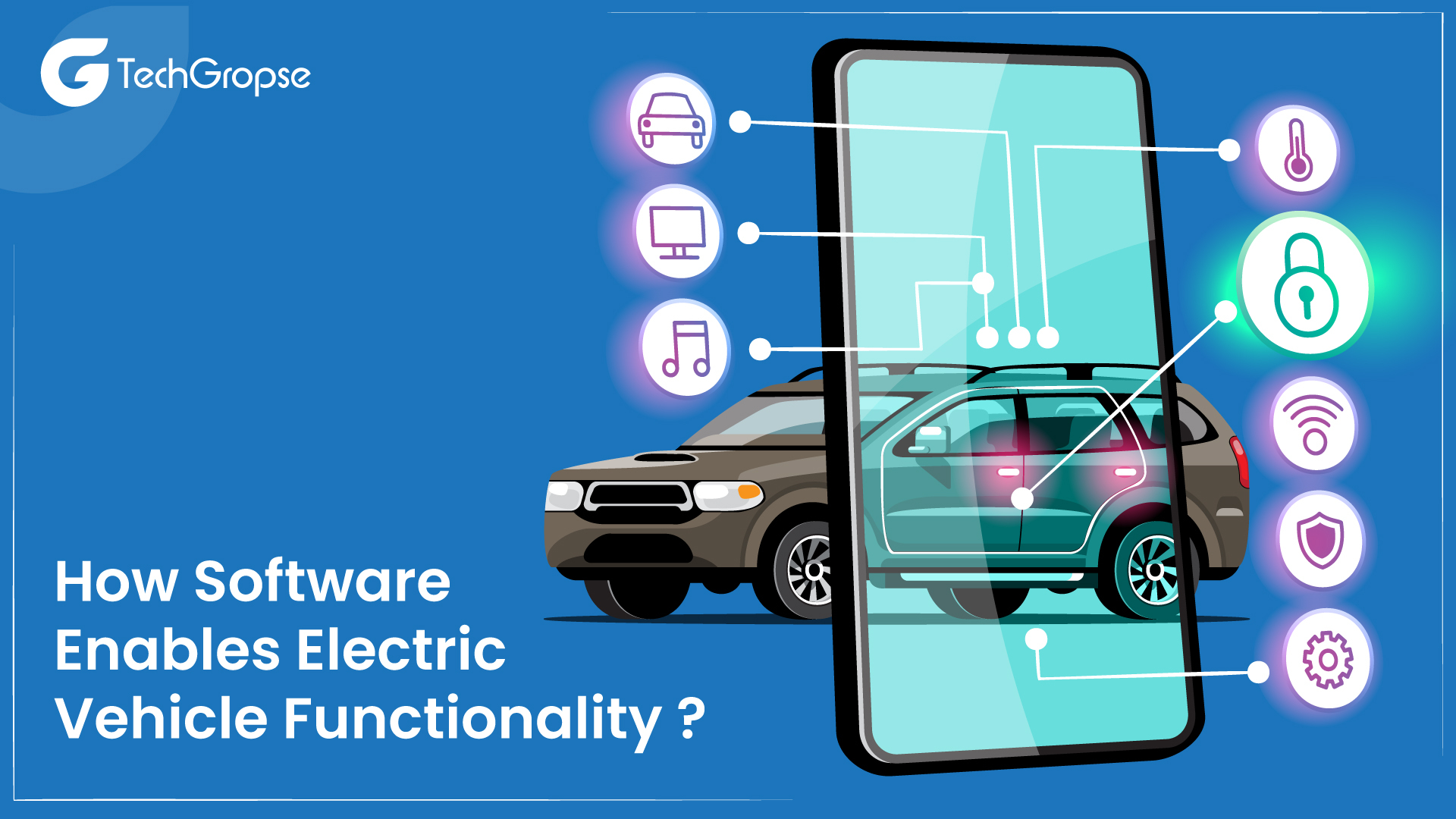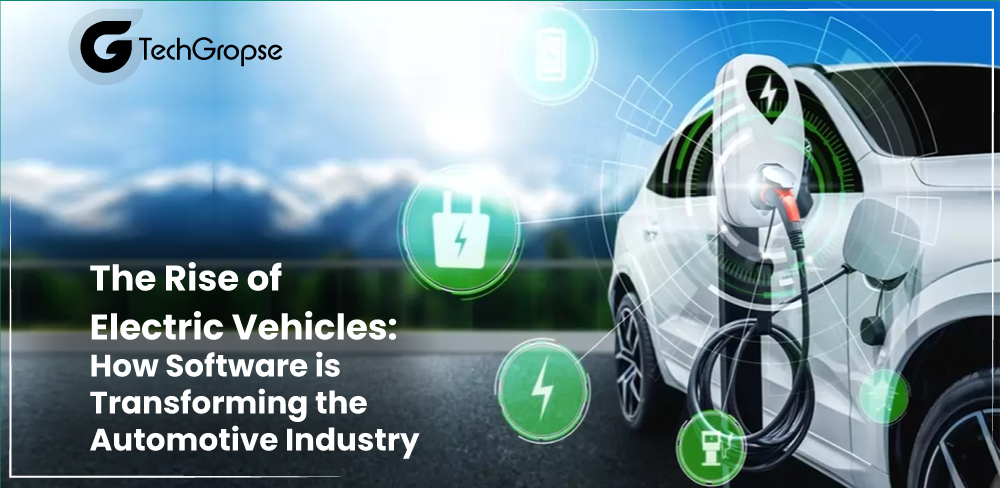The world is starting to embrace the rise of electric vehicles (EVs), and it is not just because they are environmentally friendly. With concerns about climate change and the need for sustainable transport solutions, the shift towards electric vehicles is gaining momentum faster than an EV off the starting line.
Did someone say “zero emissions”? One of the fundamental reasons for the growing prominence of electric vehicles software development and its positive impact on the environment.
Unlike their petrol-guzzling counterparts, EVs produce zero tailpipe emissions, helping to reduce air pollution and combat global warming. So, not only can you enjoy guilt-free driving, but you will also be helping to save the planet one kilometer at a time.
Well, when you think of software, you might picture your smartphone or computer, but guess what? It is also the driving force behind electric vehicles. From the moment you hop in, the software is working behind the scenes, managing everything from battery management to regenerative braking. It’s like having a tech-savvy co-pilot whispering sweet instructions into your car’s electronic systems.
In this electrifying journey, we will explore how automotive technologies are transforming the automotive industry, propelling electric vehicles to the forefront of invention and sustainability.
Revolutionary Trends in the Automotive Vehicle Market
In the midst of a rapidly and dynamic growing automotive landscape, a powerful force is revolutionizing the way we think about transportation – the rise of electric vehicles (EVs). However, beyond the remarkable advancements in battery technology and eco-conscious engineering lies another game-changer -Electric Vehicles Software.
Electric vehicles are experiencing a remarkable wave in popularity, revolutionizing the automotive industry and paving the way for a greener and more sustainable future. As concerns about climate change and environmental pollution grow, more and more people are turning to electric vehicles as an alternative to traditional gasoline-powered cars.
As per the recent report of AT Kearney, the connected mobility market will be worth about $550 billion by 2035. On the other hand, Boston Consulting Group (BCG) expects that all miles driven in the US might be in shared autonomous electric vehicles by 2030, 25%.
According to the recent forecast, barring supply chain constraints is 2 million new EVs to be sold in the USA in 2024.
How Software Enables Electric Vehicle Functionality

Software is the secret sauce that gives electric vehicles their pizzazz. It contains the motor, optimizes energy usage, and surveys battery levels, ensuring your EV is running smoothly. It is like having an automotive maestro conducting an electrifying performance on four wheels.
Software plays an essential role in helping different capabilities and functionalities in electric vehicles. It serves as the backbone that facilitates the integration and coordination of ensuring seamless performance, complex systems, efficiency, and user experience.
We uncover the key roles eScooter app development plays in driving the rise of electric vehicles and propelling the automotive industry into a greener, smarter future.
1. Vehicle Control and Power Management
Software controls the electric drivetrain, managing the flow of power from the battery to the electric motor. It tracks different vehicle parameters like temperature, speed, and state of charge to optimize power distribution and ensure efficient energy usage. This control allows for regenerative braking, smooth acceleration, and enhanced overall performance.
2. Battery Management System (BMS)
The BMS is a required software component that analyzes and controls the battery pack’s temperature, health, and charging/discharging processes. It ensures the safe and efficient operation of the battery, over-discharging, preventing overcharging, and thermal issues. The BMS also delivers real-time data on battery position to inform the driver about the remaining range and battery health.
3. Charging Infrastructure Integration
The software allows electric vehicles to communicate with charging stations, allowing charging processes. It enables access to authentication, charging networks, and billing processes. Smart charging software optimizes charging schedules based on electricity prices, grid demand, promotes efficient charging and load management.
4. Range Optimization and Energy Efficiency
Advanced software algorithms analyze driving conditions, traffic data, and battery status to optimize the vehicle’s range and energy efficiency. These algorithms help drivers plan efficient routes, manage energy consumption, and make the most of regenerative braking, enhancing the overall driving experience.
Integration of Electric Vehicles Software Development
At the heart of every electric vehicle lies its “brain” – the problematic software systems responsible for controlling and managing different components. From regulating the electric drivetrain to observing battery health and managing energy efficiency, the software optimizes the whole vehicle’s operation.
Here are some fundamental ways in which software allows electric vehicle functionality:
1. Infotainment and Connectivity
The software allows infotainment systems that deliver drivers and passengers with navigation, entertainment, and smooth connectivity features. These systems merge with smartphones and access to apps, and present hands-free calling, and voice command functionalities. Software-driven connectivity improves the overall driving experience by keeping occupants informed, entertained, and connected.
2. Over-the-Air Updates (OTA)
OTA software updates allow automakers to remotely update and improve the vehicle’s software without demanding physical visits to service centers. This capability allows manufacturers to improve performance, address bugs, and raise the latest features, keeping EVs up-to-date with the latest advancements.
3. Autonomous Driving
Software is a fundamental component of self-driving technology in electric vehicles. Complex algorithms process data from different sensors like cameras, LiDAR, and radar, to analyze the vehicle’s surroundings and make real-time decisions. Autonomous driving software is growing to reach higher levels of safety and automation.
4. Cybersecurity
As EVs become more connected, cybersecurity software safeguards against potential threats, protecting sensitive data and ensuring the safety of vehicle systems. Encryption, authentication, and intrusion detection systems are some of the software-driven security measures implemented in electric vehicles.
Essential Key Trends of the Electric Vehicles Software
Growing adoption and market penetration, advancements in battery technology, and the expansion of charging infrastructure – have created a positive feedback loop, reinforcing each other’s impact on the advancement of electric vehicles.
As more consumers embrace electric mobility, the demand for EVs continues to grow, prompting further investments in charging infrastructure and battery technology moving the electrification of the automotive industry.
1. Increasing Adoption and Market Penetration
One of the most significant trends in The Rise of Electric Vehicles is the increasing adoption and market penetration of EVs worldwide. As governments and consumers prioritize environmental sustainability and cleaner transportation options, the demand for electric vehicles has surged.
Stricter emissions regulations and incentives such as subsidies, tax credits, and access to HOV lanes have contributed to higher EV sales. This trend has been evident across different vehicle segments, such as buses, delivery vehicles, passenger cars, and commercial trucks.
2. Advancements in Battery Technology
The fast development of battery technology has been a driving force behind the growth of electric vehicles. Key advancements include enhanced longer driving ranges, energy density, faster charging capabilities, and decreasing costs per kilowatt-hour (kWh) of battery capacity.
These advancements have made electric vehicles more practical and appealing to consumers, reducing range anxiety and enhancing overall performance. As battery technology continues to enhance, electric vehicles are becoming competitive with traditional internal combustion engine vehicles in terms of range and cost.
3. Expansion of Charging Infrastructure
The growth of electric vehicles is closely linked to the development of charging infrastructure. To address range anxiety and promote EV adoption, governments, and private entities have been investing in expanding public charging networks. Fast-charging stations, in particular, have become more prevalent along main highways and in urban areas, enabling EV drivers to charge their vehicles quickly and conveniently.
Transforming User Experience: Software Interfaces and Smart Features
Gone are the days of complicated buttons and cryptic symbols. The software development company has revolutionized the user experience in electric vehicles, with elegant and reflexive interfaces that make operating your EV a breeze.
From touchscreens to voice commands, controlling your drive has never been more user-friendly. It is like having a high-tech butler that understands your every command and responds with lightning-fast efficiency.
1. Intuitive User Interfaces:
- Software interfaces in electric vehicles deliver user-friendly and intuitive controls.
- Touchscreen displays with well-organized menus allow easy access to different functions.
- Responsive design and simplified icons ensure a seamless and enjoyable user experience.
2. Customizable Personalization
- The software allows users to personalize settings and preferences.
- Drivers can choose preferred driving modes, adjust display layouts, and tailor infotainment options.
- Customization improves user comfort and convenience, making each driving experience unique.
3. Enhanced Connectivity
- Smart features allow seamless connectivity with smartphones and other devices.
- Wireless phone integration for messages, calls, and music streaming keeps drivers connected safely.
- Integration with virtual assistants like Google Assistant or Siri improves hands-free interactions.
4. Over-the-Air Updates
- Software-enabled OTA updates keep the vehicle’s software and systems up-to-date.
- Manufacturers can introduce performance enhancements, the latest features, and bug fixes remotely.
- It ensures that the EV remains cutting-edge and enhances over time without visiting a service center.
5. Voice Command and Gesture Control
- Advanced software allows for voice command integration, reducing distraction while driving.
- Gesture control enables users to interact with the infotainment system through simple hand movements.
- These smart features enhance safety and convenience during the driving experience.
6. Smart Navigation and Predictive Insights
- Software-powered navigation provides real-time traffic updates and alternative route suggestions.
- Predictive insights analyze driving patterns to offer route recommendations based on preferences and habits.
- Smart navigation optimizes travel time and energy usage, enhancing the overall driving experience.
7. Energy Management and Range Optimization
- Software-driven energy management systems monitor battery usage and efficiency.
- Range prediction algorithms offer accurate estimations based on driving behavior and conditions.
- Drivers can plan routes and charge stops effectively, reducing range anxiety.
8. Driver Assistance and Safety Features
- Software-enabled driver assistance features to enhance safety on the road.
- Adaptive cruise control, lane-keeping assist, and automated emergency braking provide added security.
- These smart features reduce driver fatigue and improve overall driving safety.
9. Enhanced Infotainment and Entertainment
- EV software interfaces offer a range of infotainment options to keep passengers engaged.
- Access to apps, streaming services, and internet browsing provide entertainment during journeys.
- This creates a more enjoyable and connected experience for all occupants.
Advancements in Autonomous Driving: Software’s Impact on EVs
Software is not just about making electric vehicles run smoothly; it is also about making driving more enjoyable. To build electric vehicles software you must include intelligent software features like lane-keeping assist, adaptive cruise control, and even self-parking capabilities, your EV becomes a cutting-edge tech hub on wheels. It is like having your own personal co-driver, ready to lend a digital hand whenever you need it.
With its integration, optimization, and user-friendly interfaces, the software is transforming the automotive industry, making EVs not just an eco-conscious choice but also an exciting and technologically advanced ride.
Get ready to embrace the electric future with open arms!
| Advancements Autonomous Driving | Software’s Impact on EVs |
| Sensor Fusion and Perception |
|
| Machine Learning and AI |
|
| Localization and Mapping |
|
| Path Planning and Decision-Making |
|
| Autonomous Control and Actuation |
|
| Redundancy and Safety Measures |
|
| Real-Time Connectivity |
|
| Over-the-Air Updates |
|
Smart Charging and Grid Integration: Software Solutions for EVs
Smart charging and grid integration are essential aspects of making EVs more practical and sustainable. Software developers play a necessary role in optimizing charging infrastructure and seamlessly integrating electric vehicles with the power grid.
Smart Charging and Grid Integration: Software Solutions for Electric Vehicles
1. Demand Response Management
- Software solutions enable demand response, allowing EV charging to be coordinated based on grid demand and electricity prices.
- Smart charging algorithms schedule charging during off-peak hours, reducing strain on the grid and optimizing energy usage.
2. Vehicle-to-Grid (V2G) Technology
- V2G technology, facilitated by software, enables bidirectional power flow between EVs and the electric grid.
- EVs can discharge excess energy back to the grid during peak demand periods, providing grid stability and additional revenue streams for EV owners.
3. Load Balancing and Peak Shaving
- Smart charging software balances charging loads to avoid excessive demand spikes.
- Peak shaving algorithms manage charging rates to reduce electricity consumption during peak hours, ensuring grid stability.
4. Dynamic Pricing and Incentives
- Software solutions implement dynamic pricing models for EV charging based on grid conditions and electricity tariffs.
- Time-of-use pricing incentivizes users to charge during low-demand periods, promoting efficient grid utilization.
5. Renewable Energy Integration
- Smart charging software integrates with renewable energy sources, such as solar and wind power.
- EVs can charge when renewable energy generation is high, contributing to a greener and more sustainable energy mix.
6. Grid Connectivity and Communication
- Software solutions enable real-time communication between EVs and the electric grid.
- Charging stations can interact with the grid to adjust charging rates and optimize energy consumption.
7. Grid Capacity Management
- Smart charging software monitors grid capacity and adjusts charging rates accordingly.
- It prevents grid overload during periods of high EV charging demand.
8. Demand Forecasting and Predictive Analytics
- Software utilizes data analytics and machine learning to forecast charging demand and grid requirements.
- Predictive analytics optimize charging schedules, ensuring EVs are charged when needed while considering grid constraints.
9. Billing and Payment Solutions
- Smart charging software facilitates seamless billing and payment for EV charging services.
- Users can access charging data and make payments through mobile apps or online platforms.
10. Cloud-Based Management
- Software solutions offer cloud-based platforms for centralized management of charging infrastructure.
- Cloud-based systems provide scalability, flexibility, and remote monitoring of charging stations.
Closing Words
With software driving the transformation of the automotive industry, the rise of electric vehicles becomes even more exciting. As we embrace the future of cleaner, smarter, and more autonomous transportation, one thing is clear – software will continue to be the driving force behind the revolution on our roads.
The rise of electric vehicles and the pivotal role of software in their development and operation have brought about a paradigm shift in the automotive industry.
As software continues to advance, it holds the potential to further enhance the efficiency, performance, and user experience of electric vehicles.
Moreover, with ongoing developments in autonomous driving, cybersecurity, and smart charging, the future of electric vehicles appears promising and exciting.
FAQ
1. How does software contribute to the efficiency of electric vehicles?
Software plays a crucial role in optimizing the efficiency of electric vehicles. Through sophisticated algorithms and AI-driven systems, the software manages various aspects of an electric vehicle, such as battery management, power distribution, and regenerative braking. By continuously analyzing data and making real-time adjustments, the software enables EVs to operate at peak efficiency, maximizing range and reducing energy consumption.
2. What are the cybersecurity challenges associated with software-driven electric vehicles?
As electric vehicles become more connected and reliant on software, ensuring cybersecurity is of paramount importance. With increased connectivity comes the potential for cyber threats, ranging from unauthorized access to vehicle systems to potential hacking risks.
3. How does software enable smart charging and grid integration for electric vehicles?
Software solutions are key to enabling smart charging and seamless integration of electric vehicles with the power grid. Intelligent software algorithms and communication protocols allow EVs to interact with charging stations, optimizing charging schedules based on factors such as electricity demand, grid stability, and renewable energy availability.










